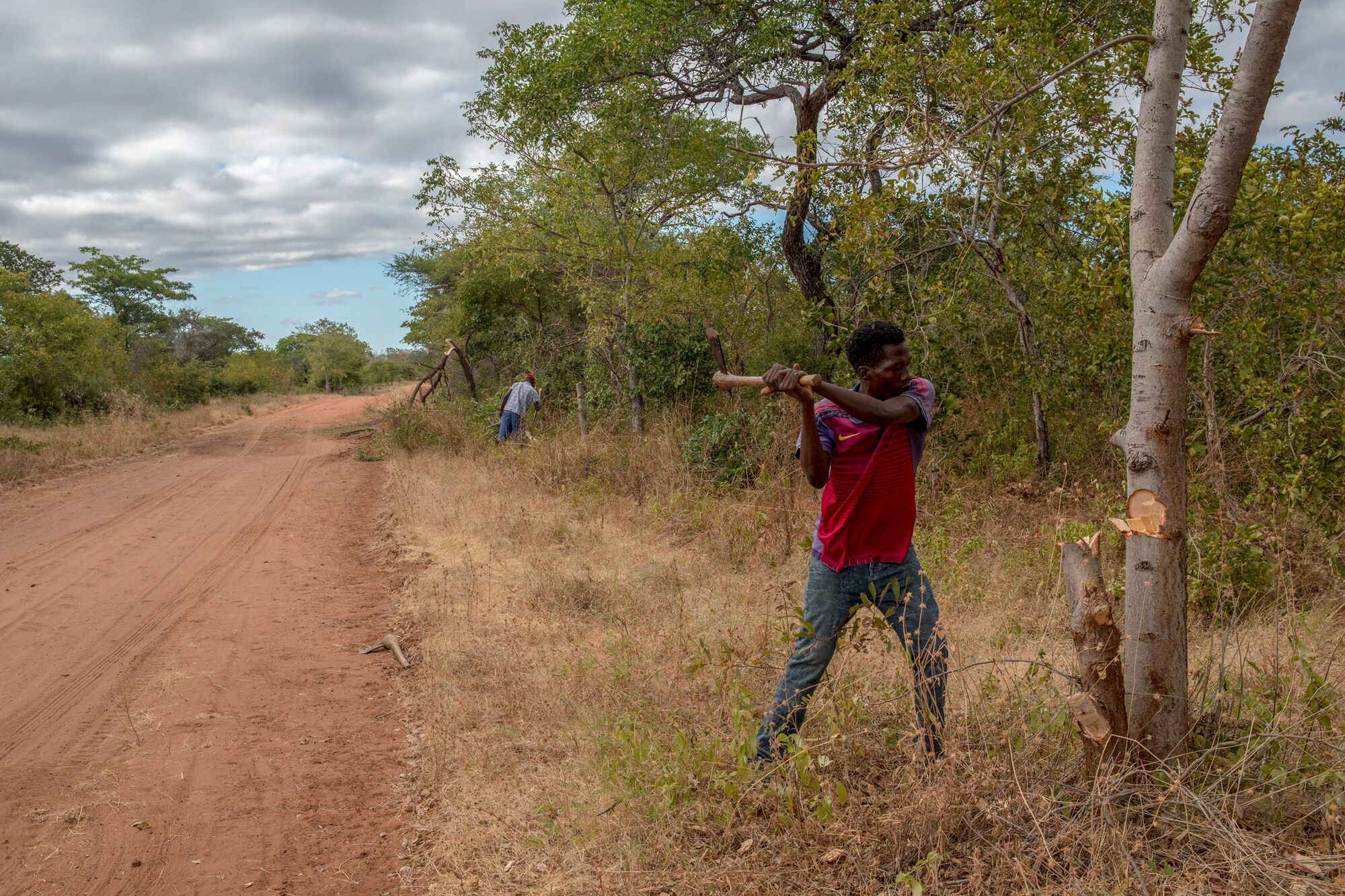“We had no idea it was carnivorous,”
one of the study’s authors said.
Story at a glance
A new study found that a common flower is actually carnivorous.
The flower, the western false asphodel, is a white flower common in the Pacific Northwest.
Researchers found that tiny hairs along the flower’s stem produce a digestive enzyme other carnivorous plants use to trap and eat insects.
A new study has discovered that what was previously considered a common flower is carnivorous.

(Courtesy of UBC and Qianshi Lin)
By Jenna Romaine | Aug. 11, 2021 | NPR
“We had no idea it was carnivorous,” Sean Graham, a botanist with the University of British Columbia and one of the study’s authors, told NPR.
Published on Monday in the Proceedings of the National Academy of Sciences of the United States of America, researchers found that the western false asphodel, a white flower common in the Pacific Northwest and first discovered in 1879, has a genetic deletion, or loss of segment of DNA, as well as features other carnivorous plants have to trap food.
“They have these sticky stems,” Graham said. “So, you know, it was kind of like, hmm, I wonder if this could be a sign that this might be carnivorous.”
The researchers found that tiny hairs along the flower’s stem produce a digestive enzyme other carnivorous plants use to trap and eat insects.
America is changing faster than ever! Add Changing America to your Facebook or Twitter feed to stay on top of the news.
There are fewer than 1,000 carnivorous plant species, and the new classification is the first carnivorous plant to be discovered in 20 years.
However, given the latest discovery, Graham believes there may be more common plants out there that are actually carnivorous.
“I suspect,” Graham said, “that there might be more carnivorous plants out there than we think”
Story at a glance
A new study found that a common flower is actually carnivorous.
The flower, the western false asphodel, is a white flower common in the Pacific Northwest.
Researchers found that tiny hairs along the flower’s stem produce a digestive enzyme other carnivorous plants use to trap and eat insects.
A new study has discovered that what was previously considered a common flower is carnivorous.

(Courtesy of UBC and Qianshi Lin)
By Jenna Romaine | Aug. 11, 2021 | NPR
“We had no idea it was carnivorous,” Sean Graham, a botanist with the University of British Columbia and one of the study’s authors, told NPR.
Published on Monday in the Proceedings of the National Academy of Sciences of the United States of America, researchers found that the western false asphodel, a white flower common in the Pacific Northwest and first discovered in 1879, has a genetic deletion, or loss of segment of DNA, as well as features other carnivorous plants have to trap food.
“They have these sticky stems,” Graham said. “So, you know, it was kind of like, hmm, I wonder if this could be a sign that this might be carnivorous.”
The researchers found that tiny hairs along the flower’s stem produce a digestive enzyme other carnivorous plants use to trap and eat insects.
America is changing faster than ever! Add Changing America to your Facebook or Twitter feed to stay on top of the news.
There are fewer than 1,000 carnivorous plant species, and the new classification is the first carnivorous plant to be discovered in 20 years.
However, given the latest discovery, Graham believes there may be more common plants out there that are actually carnivorous.
“I suspect,” Graham said, “that there might be more carnivorous plants out there than we think”
What are carnivorous plants?
New meat-eating plant discovered
11 Aug 2021

Most meat-eating plants eat insects but there are some larger plants that can eat reptiles and small mammals
Venus flytrap is one of the most well known carnivorous plants. Their leaves snap shut when prey lands

11 Aug 2021

DANILO LIMA.
Scientists have found a new carnivorous plant in North America.
The white flower might look pretty but botanists discovered that it traps prey with the sticky hairs on its stem.
The plant that traps small insects, is called triantha occidentalis, and is the first carnivorous plant to be identified in 20 years.
What are carnivorous plants?
Carnivorous plants attract, trap and digest animals for their nutrients
There is around 630 species
Scientists have found a new carnivorous plant in North America.
The white flower might look pretty but botanists discovered that it traps prey with the sticky hairs on its stem.
The plant that traps small insects, is called triantha occidentalis, and is the first carnivorous plant to be identified in 20 years.
What are carnivorous plants?
Carnivorous plants attract, trap and digest animals for their nutrients
There is around 630 species
Most meat-eating plants eat insects but there are some larger plants that can eat reptiles and small mammals
Venus flytrap is one of the most well known carnivorous plants. Their leaves snap shut when prey lands

DR. QIANSHI LIN
The flower traps prey with the sticky hairs on its stem
The meat-eating flower grows in boggy areas on the west coast of North America from California to Alaska.
They are found in major urban cities and the innocent-looking white flower might not be alone in its meaty ways.
It's thought that there may be many more carnivorous plants to be discovered.
Co-author of the study, Dr Sean Graham said: "Carnivorous plants have fascinated people since the Victorian era because they turn the usual order of things on its head: this is a plant eating animals.
"We're thrilled to have identified one growing right here in our own backyard on the west coast."

The flower traps prey with the sticky hairs on its stem
The meat-eating flower grows in boggy areas on the west coast of North America from California to Alaska.
They are found in major urban cities and the innocent-looking white flower might not be alone in its meaty ways.
It's thought that there may be many more carnivorous plants to be discovered.
Co-author of the study, Dr Sean Graham said: "Carnivorous plants have fascinated people since the Victorian era because they turn the usual order of things on its head: this is a plant eating animals.
"We're thrilled to have identified one growing right here in our own backyard on the west coast."

DANILO LIMA
Triantha occidentalis is the first new carnivorous plant identified by botanists in 20 years
"What's particularly unique about this carnivorous plant is that it traps insects near its insect-pollinated flowers," said lead author Dr. Qianshi Lin.
"On the surface, this seems like a conflict between carnivory and pollination because you don't want to kill the insects that are helping you reproduce," he added.
The researchers found that although the hairs on the stem are sticky, they only trap midges and other small insects.
Which means larger bees and butterflies are not captured and they can pollinate the flowers as they pass from plant to plant unharmed.
Triantha occidentalis is the first new carnivorous plant identified by botanists in 20 years
"What's particularly unique about this carnivorous plant is that it traps insects near its insect-pollinated flowers," said lead author Dr. Qianshi Lin.
"On the surface, this seems like a conflict between carnivory and pollination because you don't want to kill the insects that are helping you reproduce," he added.
The researchers found that although the hairs on the stem are sticky, they only trap midges and other small insects.
Which means larger bees and butterflies are not captured and they can pollinate the flowers as they pass from plant to plant unharmed.
NEW CARNIVOROUS PLANT SPECIES IDENTIFIED IN NORTH AMERICA
by Matthew Hart
Aug 11 2021 • 9:26 AM
Triantha occidentalis, a flowering plant that thrives in wetlands from Alaska all the way down through California, is common. Even around major cities along the West Coast and inland through Montana. But, like Dexter during daytime, the harmless-looking creature is hiding a deadly secrete: it kills bugs for sustenance. Placing it firmly in the little shop of horrors that consists of real-life carnivorous plants.
Gizmodo reported on the discovery, which a team of botanists from the University of Wisconsin–Madison and the University of British Columbia outlined in a study recently published in the journal PNAS. Sean Graham, a botanist at UBC, previously led an analysis of the genomes of Alismatales—a group of largely aquatic flowering plants—when his team noticed that Triantha had lost a gene often missing in carnivorous plants. Combined with its tendency to trap insects, this tipped Graham off to the idea the plant species may be carnivorous
It looks pretty but sucks nutrients from dead insects, too. 😵
a day ago By: Elana Shepert

The plant is called Triantha and it is the first new carnivorous plant to be identified by botanists in 20 years. UBC researchers explain the study. Photo via UBC
It may look like a delicate, pretty white flower — but this newly discovered plant packs a stealthy bite.
The aforementioned flower is a new finding by University of British Columbia and University of Wisconsin-Madison researchers in the peer-reviewed journal Proceedings of the National Academy of Sciences of the United States of America (PNAS).
Insects get trapped in the flower's sticky hairs and the carnivorous plant sucks nutrients from the dead corpses.
The plant is called Triantha – a species of false asphodel – and it is the first new carnivorous plant to be identified by botanists in 20 years, explains a news release. It is notable for the unusual way it traps prey with sticky hairs on its flowering stem.
“Carnivorous plants have fascinated people since the Victorian era because they turn the usual order of things on its head: this is a plant-eating animal,” said co-author Dr. Sean Graham, a professor in the department of botany at UBC. “We’re thrilled to have identified one growing right here in our own backyard on the west coast.”
Where does it grow?
Triantha grows in "nutrient-poor, boggy but bright areas" along the west coast of North America, from California to Alaska. For the study, the researchers investigated specimens growing on Cypress Mountain in North Vancouver.
“What’s particularly unique about this carnivorous plant is that it traps insects near its insect-pollinated flowers,” said lead author Dr. Qianshi Lin, a PhD student at UBCbotany at the time of the study. “On the surface, this seems like a conflict between carnivory and pollination because you don’t want to kill the insects that are helping you reproduce.”
“We believe that Triantha is able to balance carnivory with pollination because its glandular hairs are not very sticky and can only trap midges and other small insects, so that the much larger and stronger bees and butterflies that act as its pollinators are not captured,” said co-author Dr. Tom Givnish, a professor in the department of botany at the University of Wisconsin-Madison.
UBC notes that the research builds on work done previously in Graham's lab, which found that "Triantha lacked a particular gene that is often missing in other carnivorous plants."
Isotopic analysis of Triantha
To find out if the plant was "eating" insects, Lin attached fruit flies labelled with nitrogen-15 isotopes to its flowering stem. The label acted as a tracking device that allowed him to trace changes in nitrogen uptake by the plant.
He then compared the results with those from similar experiments on other species that grow in the same area, including a recognized carnivorous plant (a sundew) and several non-carnivorous plants as controls.
Isotopic analysis showed significant uptake of nitrogen by Triantha, which obtained more than half its nitrogen from prey –comparable to sundews in the same habitat, and other carnivorous plants elsewhere.
The study also found that the sticky hairs on the Triantha flower stalk produce phosphatase, a digestive enzyme used by many carnivorous plants to obtain phosphorous from prey.
The proximity of Triantha to major urban centres in western Canada and the Pacific coast in the United States suggests that other carnivorous plants – and many other ecological surprises – remain to be discovered, even in well-studied ecosystems.
But if you’re tempted to recreate the film Little Shop of Horrors or bring Triantha home to deal with pesky summer fruit flies, the researchers warn the plant doesn’t do well outside of its natural environment and advise admiring its quirks from a distance.
The full paper, “A new carnivorous plant lineage (Triantha) with a unique sticky-inflorescence trap,” will be published on Aug. 13 in PNAS.
by Matthew Hart
Aug 11 2021 • 9:26 AM
Triantha occidentalis, a flowering plant that thrives in wetlands from Alaska all the way down through California, is common. Even around major cities along the West Coast and inland through Montana. But, like Dexter during daytime, the harmless-looking creature is hiding a deadly secrete: it kills bugs for sustenance. Placing it firmly in the little shop of horrors that consists of real-life carnivorous plants.
Gizmodo reported on the discovery, which a team of botanists from the University of Wisconsin–Madison and the University of British Columbia outlined in a study recently published in the journal PNAS. Sean Graham, a botanist at UBC, previously led an analysis of the genomes of Alismatales—a group of largely aquatic flowering plants—when his team noticed that Triantha had lost a gene often missing in carnivorous plants. Combined with its tendency to trap insects, this tipped Graham off to the idea the plant species may be carnivorous
.
Danilo Lima
The study’s lead author, Qianshi Lin, a doctoral student at UBC, performed experiments to determine if T. occidentalis is indeed carnivorous. He and his team did so by labeling fruit flies with the stable isotope, nitrogen-15; a non-radioactive isotope that’s able to act as a tracer, in turn allowing scientists to model chemical and biochemical systems. Lo and behold, the team found that the unassuming plant devoured and processed the nutrients from the bugs it’d trapped.
“What’s particularly unique about this carnivorous plant is that it traps insects near its insect-pollinated flowers,” Lin said in a press release. “On the surface, this seems like a conflict between carnivory and pollination because you don’t want to kill the insects that are helping you reproduce.”
T. occidentalis has managed to thrive with thus duality, however. And the species now stands as the 12th independent evolution of carnivory in the plant kingdom scientists are aware of. As well as the first time they’ve discovered the trait in the Alismatales order. Athough we’re still not sure if Audrey II should be counted as a 13th lineage.

Danilo Lima
The study’s lead author, Qianshi Lin, a doctoral student at UBC, performed experiments to determine if T. occidentalis is indeed carnivorous. He and his team did so by labeling fruit flies with the stable isotope, nitrogen-15; a non-radioactive isotope that’s able to act as a tracer, in turn allowing scientists to model chemical and biochemical systems. Lo and behold, the team found that the unassuming plant devoured and processed the nutrients from the bugs it’d trapped.
“What’s particularly unique about this carnivorous plant is that it traps insects near its insect-pollinated flowers,” Lin said in a press release. “On the surface, this seems like a conflict between carnivory and pollination because you don’t want to kill the insects that are helping you reproduce.”
T. occidentalis has managed to thrive with thus duality, however. And the species now stands as the 12th independent evolution of carnivory in the plant kingdom scientists are aware of. As well as the first time they’ve discovered the trait in the Alismatales order. Athough we’re still not sure if Audrey II should be counted as a 13th lineage.
UBC researchers discover first new carnivorous plant in 20 years
It looks pretty but sucks nutrients from dead insects, too. 😵
a day ago By: Elana Shepert

The plant is called Triantha and it is the first new carnivorous plant to be identified by botanists in 20 years. UBC researchers explain the study. Photo via UBC
It may look like a delicate, pretty white flower — but this newly discovered plant packs a stealthy bite.
The aforementioned flower is a new finding by University of British Columbia and University of Wisconsin-Madison researchers in the peer-reviewed journal Proceedings of the National Academy of Sciences of the United States of America (PNAS).
Insects get trapped in the flower's sticky hairs and the carnivorous plant sucks nutrients from the dead corpses.
The plant is called Triantha – a species of false asphodel – and it is the first new carnivorous plant to be identified by botanists in 20 years, explains a news release. It is notable for the unusual way it traps prey with sticky hairs on its flowering stem.
“Carnivorous plants have fascinated people since the Victorian era because they turn the usual order of things on its head: this is a plant-eating animal,” said co-author Dr. Sean Graham, a professor in the department of botany at UBC. “We’re thrilled to have identified one growing right here in our own backyard on the west coast.”
Where does it grow?
Triantha grows in "nutrient-poor, boggy but bright areas" along the west coast of North America, from California to Alaska. For the study, the researchers investigated specimens growing on Cypress Mountain in North Vancouver.
“What’s particularly unique about this carnivorous plant is that it traps insects near its insect-pollinated flowers,” said lead author Dr. Qianshi Lin, a PhD student at UBCbotany at the time of the study. “On the surface, this seems like a conflict between carnivory and pollination because you don’t want to kill the insects that are helping you reproduce.”
“We believe that Triantha is able to balance carnivory with pollination because its glandular hairs are not very sticky and can only trap midges and other small insects, so that the much larger and stronger bees and butterflies that act as its pollinators are not captured,” said co-author Dr. Tom Givnish, a professor in the department of botany at the University of Wisconsin-Madison.
UBC notes that the research builds on work done previously in Graham's lab, which found that "Triantha lacked a particular gene that is often missing in other carnivorous plants."
Isotopic analysis of Triantha
To find out if the plant was "eating" insects, Lin attached fruit flies labelled with nitrogen-15 isotopes to its flowering stem. The label acted as a tracking device that allowed him to trace changes in nitrogen uptake by the plant.
He then compared the results with those from similar experiments on other species that grow in the same area, including a recognized carnivorous plant (a sundew) and several non-carnivorous plants as controls.
Isotopic analysis showed significant uptake of nitrogen by Triantha, which obtained more than half its nitrogen from prey –comparable to sundews in the same habitat, and other carnivorous plants elsewhere.
The study also found that the sticky hairs on the Triantha flower stalk produce phosphatase, a digestive enzyme used by many carnivorous plants to obtain phosphorous from prey.
The proximity of Triantha to major urban centres in western Canada and the Pacific coast in the United States suggests that other carnivorous plants – and many other ecological surprises – remain to be discovered, even in well-studied ecosystems.
But if you’re tempted to recreate the film Little Shop of Horrors or bring Triantha home to deal with pesky summer fruit flies, the researchers warn the plant doesn’t do well outside of its natural environment and advise admiring its quirks from a distance.
The full paper, “A new carnivorous plant lineage (Triantha) with a unique sticky-inflorescence trap,” will be published on Aug. 13 in PNAS.
North Shore bog plant is a meat eater, UBC study finds
Brent Richter

Brent Richter

Tiny bugs are trapped in the sticky hairs of carnivorous Triantha occidentalis.▲


The flower of Triantha occidentalis may be beautiful but the stem is deadly to small bugs▲
Six-leggeds beware: UBC scientists have discovered a plant common in the bogs of the North Shore Mountains that traps and digests insects.
“It’s a big surprise. Many people who hike in Vancouver or B.C. will be familiar with this plant,” said Sean Graham, UBC professor and co-author of a newly published study. “No one ever thought that it was a carnivore. This is the shocking thing about it.”
Like other carnivorous plants, Triantha occidentalis, tends to live in boggy areas where the soil lacks important nutrients like nitrogen and phosphorous.
The UBC researchers had a suspicion it may be a meat-eater after a previous genetic survey found Triantha occidentalis is missing a gene that often is absent in carnivorous plants. To test out the theory, the study’s lead author Qianshi Lin designed an experiment using fruit flies that had been raised in an environment full of nitrogen-15 isotopes. The flies were then humanely killed and attached to tiny hairs on the plants’ stems, which exude a sticky secretion that traps bugs.
“If the plant is carnivorous and digests the insect, which it appears to do, you can track to see if that nutrient-level nitrogen flows into the plant,” he said. “And indeed it does.”
They estimate as much as half or two-thirds of the Triantha occidentalis’ intake of nitrogen, which is a necessity for making proteins and DNA, comes from bugs, not the soil.
This is the first time a plant has been discovered to be carnivorous in 20 years. In Canada, there are now only 19 confirmed carnivorous species, and around the world, there are about 600 – a tiny proportion of our overall fauna.
“It's not every day that you have a completely new sort of instance of a carnivorous plant. This probably has evolved independently of other ones,” Graham said.
“Carnivorous plants” may call to mind David Attenborough narrating as small rodents disappear into the gaping maw of a tropical pitcher plant, or perhaps Little Shop of Horrors, a dark musical comedy about an extraterrestrial plant named Audrey II that demands human blood for its survival.
But the ones on the North Shore and other bogs along the West Coast are unlikely to devour anything bigger than a midge. The hairs on the stem simply aren’t big enough to trap larger bugs like bees or butterflies, which is likely an evolutionary strategy as the plant relies on those species for pollination.
Carnivorous plants have been a point of fascination for Western botanists and horticulturalists since the Victorian era, Graham said.
“Frankly they're a bit creepy. I mean it’s kind of ghoulish to have a plant that eats animals right?” he said. “I think that’s what gathers the attention of the public – the idea that the tables can be turned sometimes.”
While it’s anyone’s guess whether the discovery will have applicability outside botany, it will open the door to more research into the “extreme adaptations” of plants.
“We’re hoping that by looking into the genome in the future, we can actually see some of these changes and answer the question of what does it take to be a meat-eating plant?” Graham said.
Lin and Graham’s paper will be published in the peer-reviewed Proceedings of the National Academy of Sciences journal this month.
“I hope it inspires other people to think about plants more and the fact that we found this basically living in Vancouver. It's pretty remarkable,” Graham said.
Six-leggeds beware: UBC scientists have discovered a plant common in the bogs of the North Shore Mountains that traps and digests insects.
“It’s a big surprise. Many people who hike in Vancouver or B.C. will be familiar with this plant,” said Sean Graham, UBC professor and co-author of a newly published study. “No one ever thought that it was a carnivore. This is the shocking thing about it.”
Like other carnivorous plants, Triantha occidentalis, tends to live in boggy areas where the soil lacks important nutrients like nitrogen and phosphorous.
The UBC researchers had a suspicion it may be a meat-eater after a previous genetic survey found Triantha occidentalis is missing a gene that often is absent in carnivorous plants. To test out the theory, the study’s lead author Qianshi Lin designed an experiment using fruit flies that had been raised in an environment full of nitrogen-15 isotopes. The flies were then humanely killed and attached to tiny hairs on the plants’ stems, which exude a sticky secretion that traps bugs.
“If the plant is carnivorous and digests the insect, which it appears to do, you can track to see if that nutrient-level nitrogen flows into the plant,” he said. “And indeed it does.”
They estimate as much as half or two-thirds of the Triantha occidentalis’ intake of nitrogen, which is a necessity for making proteins and DNA, comes from bugs, not the soil.
This is the first time a plant has been discovered to be carnivorous in 20 years. In Canada, there are now only 19 confirmed carnivorous species, and around the world, there are about 600 – a tiny proportion of our overall fauna.
“It's not every day that you have a completely new sort of instance of a carnivorous plant. This probably has evolved independently of other ones,” Graham said.
“Carnivorous plants” may call to mind David Attenborough narrating as small rodents disappear into the gaping maw of a tropical pitcher plant, or perhaps Little Shop of Horrors, a dark musical comedy about an extraterrestrial plant named Audrey II that demands human blood for its survival.
But the ones on the North Shore and other bogs along the West Coast are unlikely to devour anything bigger than a midge. The hairs on the stem simply aren’t big enough to trap larger bugs like bees or butterflies, which is likely an evolutionary strategy as the plant relies on those species for pollination.
Carnivorous plants have been a point of fascination for Western botanists and horticulturalists since the Victorian era, Graham said.
“Frankly they're a bit creepy. I mean it’s kind of ghoulish to have a plant that eats animals right?” he said. “I think that’s what gathers the attention of the public – the idea that the tables can be turned sometimes.”
While it’s anyone’s guess whether the discovery will have applicability outside botany, it will open the door to more research into the “extreme adaptations” of plants.
“We’re hoping that by looking into the genome in the future, we can actually see some of these changes and answer the question of what does it take to be a meat-eating plant?” Graham said.
Lin and Graham’s paper will be published in the peer-reviewed Proceedings of the National Academy of Sciences journal this month.
“I hope it inspires other people to think about plants more and the fact that we found this basically living in Vancouver. It's pretty remarkable,” Graham said.
New Lineage of Carnivorous Plants Discovered
Aug 10, 2021 by News Staff / Source
The newly-identified lineage of carnivorous plants is represented by the western false asphodel (Triantha occidentalis), a species of flowering plant from North America; its trap is unique among carnivorous plants and, unexpected based on theory, in placing all of its prey-capture sites next to its insect-pollinated flowers.
Flower of the western false asphodel (Triantha occidentalis) at Cypress Provincial Park, British Columbia, Canada. Image credit: Danilo Lima.
“Carnivorous plants have fascinated people since the Victorian era because they turn the usual order of things on its head: this is a plant eating animals,” said Professor Sean Graham, a researcher in the Department of Botany and the Botanical Garden at the University of British Columbia.
“We’re thrilled to have identified one growing right here in our own backyard on the west coast.”
Triantha occidentalis can be found in the wetlands and bogs from Alaska to California and inland to Montana.
In the summer, it shoots up tall flowering stems coated with sticky hairs that trap small insects like gnats and midges.
“What’s particularly unique about this carnivorous plant is that it traps insects near its insect-pollinated flowers,” said Qianshi Lin, a doctoral student in the Department of Botany and the Botanical Garden at the University of British Columbia.
“On the surface, this seems like a conflict between carnivory and pollination because you don’t want to kill the insects that are helping you reproduce.”
“However, the plant appears to be capable of sorting out friend from food.”
“We believe that Triantha occidentalis is able to do this because its glandular hairs are not very sticky, and can only entrap midges and other small insects, so that the much larger and stronger bees and butterflies that act as its pollinators are not captured,” said Professor Tom Givnish, a researcher in the Department of Botany at the University of Wisconsin-Madison.
In their study, the reseachers discovered that Triantha occidentalis acquires more than half of its nitrogen (N) by digesting these ensnared insects, a welcome treat in its nutrient-poor habitat.
“We tested the hypothesis that Triantha occidentalis is carnivorous by doing a field experiment with 15N-labeled insects to demonstrate nutrient uptake,” they said.
“We demonstrated significant N transfer from prey to Triantha, with an estimated 64% of leaf N obtained from prey capture in previous years, comparable to levels inferred for the cooccurring round-leaved sundew, a recognized carnivore.”
“N obtained via carnivory is exported from the inflorescence and developing fruits and may ultimately be transferred to next year’s leaves.”
“Glandular hairs on flowering stems secrete phosphatase, as seen in all carnivorous plants that directly digest prey.”
This is the 12th known independent evolution of carnivory in the plant kingdom.
It is the first time the trait has been discovered in the Alismatales order, a group of largely aquatic flowering plants.
It is also just the fourth established instance of carnivory in the monocots, one of the major groups of flowering plants.
Some other species in the Triantha genus also have sticky hairs that trap insects. The authors plan to study these species to see how widespread carnivory might be in the genus.
“It seems likely that there are other members of this group that will turn out to be carnivorous,” Professor Givnish said.
“The fact that Triantha’s carnivorous lifestyle escaped notice for so long despite the plant’s abundance and its growth near large cities suggests that more carnivorous plants are waiting to be discovered off the beaten path.”
The team’s paper was published in the Proceedings of the National Academy of Sciences.
_____
Qianshi Lin et al. 2021. A new carnivorous plant lineage (Triantha) with a unique sticky-inflorescence trap. PNAS 118 (33): e2022724118; doi: 10.1073/pnas.2022724118
The newly-identified lineage of carnivorous plants is represented by the western false asphodel (Triantha occidentalis), a species of flowering plant from North America; its trap is unique among carnivorous plants and, unexpected based on theory, in placing all of its prey-capture sites next to its insect-pollinated flowers.
Flower of the western false asphodel (Triantha occidentalis) at Cypress Provincial Park, British Columbia, Canada. Image credit: Danilo Lima.
“Carnivorous plants have fascinated people since the Victorian era because they turn the usual order of things on its head: this is a plant eating animals,” said Professor Sean Graham, a researcher in the Department of Botany and the Botanical Garden at the University of British Columbia.
“We’re thrilled to have identified one growing right here in our own backyard on the west coast.”
Triantha occidentalis can be found in the wetlands and bogs from Alaska to California and inland to Montana.
In the summer, it shoots up tall flowering stems coated with sticky hairs that trap small insects like gnats and midges.
“What’s particularly unique about this carnivorous plant is that it traps insects near its insect-pollinated flowers,” said Qianshi Lin, a doctoral student in the Department of Botany and the Botanical Garden at the University of British Columbia.
“On the surface, this seems like a conflict between carnivory and pollination because you don’t want to kill the insects that are helping you reproduce.”
“However, the plant appears to be capable of sorting out friend from food.”
“We believe that Triantha occidentalis is able to do this because its glandular hairs are not very sticky, and can only entrap midges and other small insects, so that the much larger and stronger bees and butterflies that act as its pollinators are not captured,” said Professor Tom Givnish, a researcher in the Department of Botany at the University of Wisconsin-Madison.
In their study, the reseachers discovered that Triantha occidentalis acquires more than half of its nitrogen (N) by digesting these ensnared insects, a welcome treat in its nutrient-poor habitat.
“We tested the hypothesis that Triantha occidentalis is carnivorous by doing a field experiment with 15N-labeled insects to demonstrate nutrient uptake,” they said.
“We demonstrated significant N transfer from prey to Triantha, with an estimated 64% of leaf N obtained from prey capture in previous years, comparable to levels inferred for the cooccurring round-leaved sundew, a recognized carnivore.”
“N obtained via carnivory is exported from the inflorescence and developing fruits and may ultimately be transferred to next year’s leaves.”
“Glandular hairs on flowering stems secrete phosphatase, as seen in all carnivorous plants that directly digest prey.”
This is the 12th known independent evolution of carnivory in the plant kingdom.
It is the first time the trait has been discovered in the Alismatales order, a group of largely aquatic flowering plants.
It is also just the fourth established instance of carnivory in the monocots, one of the major groups of flowering plants.
Some other species in the Triantha genus also have sticky hairs that trap insects. The authors plan to study these species to see how widespread carnivory might be in the genus.
“It seems likely that there are other members of this group that will turn out to be carnivorous,” Professor Givnish said.
“The fact that Triantha’s carnivorous lifestyle escaped notice for so long despite the plant’s abundance and its growth near large cities suggests that more carnivorous plants are waiting to be discovered off the beaten path.”
The team’s paper was published in the Proceedings of the National Academy of Sciences.
_____
Qianshi Lin et al. 2021. A new carnivorous plant lineage (Triantha) with a unique sticky-inflorescence trap. PNAS 118 (33): e2022724118; doi: 10.1073/pnas.2022724118











/cloudfront-us-east-1.images.arcpublishing.com/mco/23CKMUHDKJBUJLD7UUQWMJ2YOA.jpg)
/cloudfront-us-east-1.images.arcpublishing.com/mco/7PRS3G75ZRFFXE6D2SSAND3MHI.jpg)
/cloudfront-us-east-1.images.arcpublishing.com/mco/N3LOJY7J6BDNZLRZJLOI64UP7I.jpg)